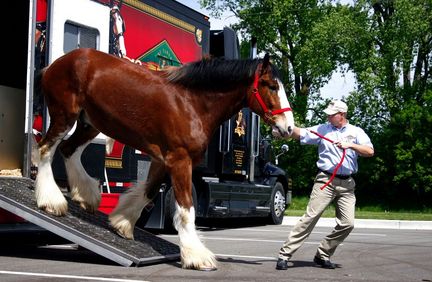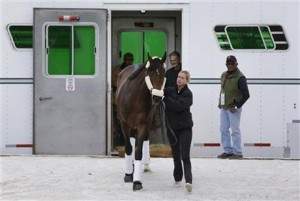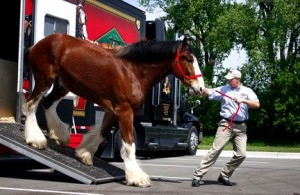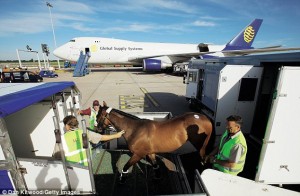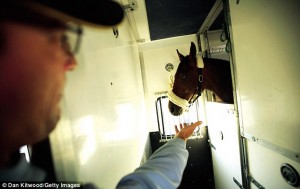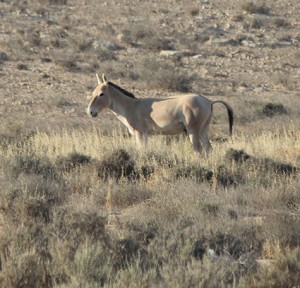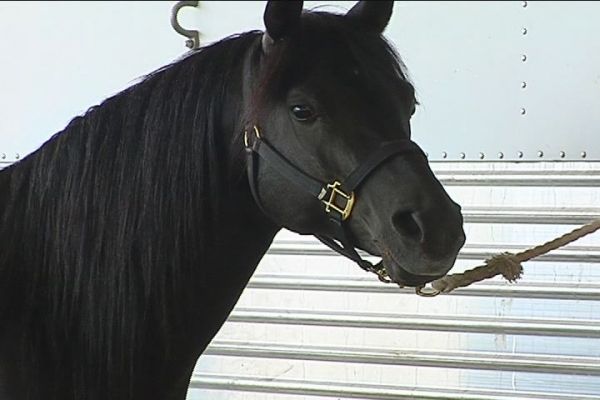Here’s the rest of Rachael Kraft’s fascinating article. Just think about how horses are transported around the world for shows and races the next time you’re coaxing one into your trailer. I’ve met a few transporters on the Black Stallion movies, which was very interesting for me, but only one small job on their list. You can imagine the responsibility of moving multimillion dollar horses from one race to the next! Movie stars – no big deal!
Always more to see & do at ; www.theBlackStallion.com
And now for the rest of the story …
Traveling inStyle
By: Rachael Kraft *Representative of Double D Trailers: Horse Trailer Manufacturer since 1997 with emphasis on research, design, product improvement and horse safety through creation of safer technologies. Owned by Brad Heath.
For humans, we have the choice of car or truck…train or bus…economy or first class. Wherever we go, we’d like to get there quickly, comfortably, and without a lot of hassle. Some horses travel just as much or more than the typical person and they have the added challenge of weighing close to a ton! Whether the horse is an elite athlete, a show performer or a beloved pet, they still have the ability to travel in style.
In the horse world, the most recent example of horses traveling in style is the group of talented three-year-olds competing in this year’s Triple Crown. This prestigious set of three grueling races starts in the rolling hills of bluegrass state with the Kentucky Derby. The horse Orb gave us a thrilling victory at the 2013 race and many hoped he would be a three-win contender. His hopes were dashed when he was defeated at the second race, The Preakness, held at Pimlico Racetrack in Maryland. Only one more race remained, and fans across the nation were eagerly awaiting the Belmont Stakes on Saturday, June 8 where Orb got a chance to meet his rival Oxbow in the 1 1/2 mile challenge.
Many spectators forget what a terrific challenge the Triple Crown is for a young horse. After all, they are only three-years-old. In many other horse disciplines, a horse this young would barely be starting the training for their sport. For a racehorse, they are expected to be at their very best. Each of the races is a physical and mental stress on the animal and there are only days between each of the races. In addition, the horses need to travel hundreds of miles, settle into a new stable, and prepare on a new racetrack.
It’s not surprising that Orb’s trainer, Shug McGaughey considered not racing his colt in the Belmont after a fourth place finish at the Preakness. Lucky for us, he announced that his colt would definitely race on Saturday. He made this decision after Orb ran a good workout last Sunday morning1. In the end, the exciting showdown between Orb and Oxbow didn’t matter. A 15-1 longshot named Palace Malice beat them both to the wire! Oxbow came in 2nd and Orb came in 3rd. Nothing is every predictable in the world of horseracing.
Derby winner Orb arrives at Pimlico for Preakness5.
A question still remains. Just how do elite racehorses travel from state to state to compete? Is it possible that you passed a world-class racehorse while traveling the interstate? In short…yes. For most racehorses, they travel in plush horse vans or trucks that travel on the highways. These vehicles have many of the same features as regular horse trailers, but are often air ride equipped to provide an extra smooth ride. The long trailers will have wide doors, low ramps, extra storage space, excellent ventilation and feature some high-tech amenities. Drivers will use two-way radios and GPS to find their destination while using closed circuit cameras to monitor their equine passengers8. All of this effort is taken so that the racehorse can arrive at the track in top shape to prepare for their race.
Racehorses aren’t the only equines that travel hundreds of miles by road. Meet the Budweiser Clydesdales. These beautiful teams of draft horses travel the country to make appearances at parades and sporting events. During their demonstrations, eight breath-taking animals pull an immense red cart full of products to be delivered. The team is driven by two handlers and overseen by a sturdy Dalmatian dog. These cart horses show their great strength and agility by maneuvering the cart and even “parking” it at an imaginary loading bay. It is truly a treat to see them on display.
Three teams of ten horses each travel the country to put on demonstrations. They perform at a new destination each week, which means a great deal of time on the road. In order to keep the horses happy and healthy, the horse handlers limit their travel to 500 miles a day and stop for breaks every two to three hours. “If it’s going to be a longer haul than that we’ll find an overnight along the way to stop,” said horse handler Dave Thomas. “We won’t haul more than two days in a row; if it’s longer than a two-day trip then we’ll have a rest day built in. 6”
The horses are frequently checked to avoid the main health concern – colic. Luckily, Thomas said severe bouts of colic are rare. “We’re pretty careful. That’s one of the main reasons we try not to drive over 500 miles a day. We don’t (want to) stress them out.” Once they arrive at their destination, the horses are turned out or taken for walks. They even have a special sled for the horses to pull for some exercise6.
The Budweiser Clydesdale trailer is hard to miss. It is a massive red tractor-trailer with an image of the Clydesdales prancing across the side. The trailer needs to carry ten draft horses, the crew, portable stalls, grooming supplies, basic vet supplies, and shoeing supplies. Grain, hay, and shavings are shipped ahead to their destination. They carry anything that you would need to care for a horse when you’re on the road 10-11 months of the year. Watch a video interview with Dave Thomas here (http://www.thehorse.com/videos/31711/budweiser-clydesdales-whats-in-the-trailer) 6.
TimesBudweiser employee Brady Bardin of Booneville, Miss. leads one of the Budweiser
Clydesdale horses out of its trailer outside Fabiano Brothers Inc. in Michigan7.
For even longer trips, horses cannot be transported by road and must take to the skies. The mighty Breeder’s Cup race features many horses from other countries who travel in planes to reach the event. “They travel first-class,” said Chris Santarelli. “They each want their own stall.” Santarelli is the treasurer of the Mersant International Ltd., which is the official transport coordinator for the Breeder’s Cup2.
“It is a major undertaking,” Chris Burke explained. Burke is the co-owner and operator for International Racehorse Transport, which files 5,000 horses each year. “Each air stable can hold three horses. So if you were traveling from Australia to England, three to a stall is the equivalent of economy ($17,500), two to a stall is business class ($30,000), and one horse on its own is first class ($50,000)3.”
A horse is shown here entering their jet stall for a trip aboard a plane.4
The horses don’t usually have problems with the flight. “A racehorse is usually a very disciplined animal,” says Andrea Branchini, manager of Horse America Inc. “He will travel very well. It will go up a ramp. It will go into a stall on a plane. 2” This is not to say that all of the horses are calm, cool and collected. “When you have some two-year-olds racing, you do tend to get horses that have never traveled to America. You worry a bit about hose horses in flight,” said Santerelli.2
The horses are under constant surveillance while in the sky. Grooms check them frequently to make sure they are not showing signs of dehydration or restlessness. They are given plenty of water and hay. Handlers regularly check horses’ pulses and make sure they are eating and drinking enough.
A horse in his jet stall while on board a plane4.
Each horse carries a passport that contains information about their coloring and identifying features. The passport also contains their inoculation record. For the Breeder’s Cup horses, once they reach Churchill Downs, they are put under a 42-hour quarantine to check for a normal temperature and blood tests for four diseases: glanders, piroplasmosis, equine infectious anemia, and dourine2. When they are given the all-clear they are ready to leave quarantine to prepare for the race.
Since it seems like such a hassle, you might wonder why an owner would bother to transport their horses such long distances for competitions? For racehorse owners, the prestige of winning internationally can boost a horses breeding value after they leave the track3. For other horses, special events like the Olympics, Rolex Three-Day Event, and World Equestrian Games will draw international competitors.
Click here (http://www.business-opportunities.biz/2012/03/08/how-do-you-ship-a-horse-to-the-olympics/) to see an excellent video of horses being transported to the 2010 Horse World Cup in Las Vegas9.
For the average horseperson, we don’t have any upcoming plans of taking wild cross country road trips or traveling internationally to compete. Still, your horse deserves every bit of concern and care as these elite athletes and performers. That is why is extremely important to find a horse trailer that has the best safety features for your horse. DoubleD Trailers is an excellent example of a company that provides fantastic horse trailers (http://www.doubledtrailers.com/Horse_Trailer_Models.htm) to transport your horse. They provide many different models to fit your individual needs10. Whether it be in a trailer, horse van, or in a plane, it can be certain that horses can truly travel in style.
SOURCES:
1. Bien, Louis. SBNation. Belmont Stakes 2013: Orb to run last leg of Triple Crown. Jun 2 2013. Available: http://www.sbnation.com/2013/6/2/4388486/2013-belmont-stakes-news-orb-running
2. Laidman, Jenni. Louisville Magazine. Flying horses: How foreign race horses get to Churchill Downs [Breeders’ Cup]. Nov 4 2010. Available: http://www.louisville.com/content/flying-horses-how-foreign-race-horses-get-churchill-downs-breeders-cup
3. McKenzie, Sheena. CNN. Flying high: From ‘cattle-class’ to ‘horse-class’. March 22 2013. Available: http://edition.cnn.com/2013/03/22/sport/air-travel-race-horse-flying-class
4. Image: Robinson, Philip. DailyMailUK. Welcome to Horse Air – how the world’s most elite horses are transported. Accessed June 4 2013. Available: http://www.dailymail.co.uk/home/moslive/article-2131554/Queens-Diamond-Jubilee-Welcome-Horse-Air–worlds-elite-horses-transported.html
5. Image: WCMH-News. Derby winner Orb arrives at Pimlico for Preakness – Available: www.nbc4i.com
6. Larson, Erica. TheHorse.com. Caring for the Budweiser Clydesdales. April 23 2013. Available: http://www.thehorse.com/articles/31736/caring-for-the-budweiser-clydesdales?utm_source=Newsletter&utm_medium=health-news&utm_campaign=04-23-2013
7. Image: TimesBudweiser employee Brady Bardin of Booneville, Miss. leads one of the Budweiser Clydesdale horses out of its trailer outside Fabiano Brothers Inc. in Monitor Township on Tuesday. Accessed June 4 2013. Available: http://www.mlive.com/news/bay-city/index.ssf/2010/05/mid-michigan_evening_links_bud.html
8. Elite Horse Transport. Accessed June 4 2013. Available: http://elitehorsetransport.com/
9. Video: Carlson, Dane. How Do You Ship A Horse to the Olympics? March 8 2012. Available: http://www.business-opportunities.biz/2012/03/08/how-do-you-ship-a-horse-to-the-olympics/
10. Double D Trailers. Accessed June 4 2013. http://www.doubledtrailers.com/Horse_Trailer_Models.htm

